One of the most attractive parts of the city is Montjuic mountain. Which blends art, culture sport, and history.
Montjuic today is far removed from the Iberian city of Laya which was situated here; also lost in the mists of time is the time the Romans built here to their God, Jupiter. Some historians claim that this is the origin of the name of the mountain: Mons Jovis, Monte de Jupiter, Montjuic. Other historians say that nearer to our times there was a Jewish cemetery that gave the mountain its name, others state that the name was due to the great fame and influence in the city life of a Hebrew family called Mont Judaic.
Nowadays we must agree that the great esteem the people of Barcelona have for Montjuic, reached its maximum with the celebration of the 1992 Olympic Games which converted the mountain into a center of worldwide attraction, and permitted the realization of a dream.
The mountain can be reached from several directions. One of these is from the Placa d’ Espanya, in the Gran Via de Les Corts Catalanes at the beginning of Passeig de Maria Cristina which leads to Montjuic by the Font Magica. In the Placa de Espanya, there is a central fountain called Font Monumental, the work of the architect Jujol and decorated with sculptures by Osle. The fountain has three sides which represent the three seas that bathe the Iberian Peninsula: the Mediterranean, the Atlantic, and the Cantabric.
Another way to get there is by Miramar, which we can reach from three directions: the costa de Miramar, the aerial cable car, or the Funicular.
However, present-day Montjuic must begin by mentioning the great historical and archaeological value of the Castell, donated by the Army to the city and, once restored to its original state, converted into Museo Historico Militar. The museum contains an unusual variety of valuable collections of all kinds.
Also worthy of looking at are the gardens of this mountain, such as Miramar, Laribal, La Rosaleda, and Font del Gat, or those of Mosen Cinto Verdaguer, a monographic exhibition of bulbs, cactus, and other plants. The gardens Costa and Llobera, Joan Maragall, and those of the 1929 Exhibition, designed by the Frenchman Forestier, frames the now large area of the industrial fair.
A large number of exhibitions are held in this area every year, which has made Barcelona very popular from this point of view. This area covers approximately 15,000 square meters with several “palaces”. One of them, the Palau de les Nacions has a hall with a capacity for 1,500 congress members.
One of the beautiful buildings on Montjuic is the Palacete ( little palace ) Albeniz, which is the residence of the Spanish Royal family on their visits to Barcelona. It was a project of Ros de Ramis, Ignacio Serra-goday and Antonio Lozoya. Inside are arts works by Nonell, Casas, Rusinol, Marti Alsina, Baixeras, Bay-reda, Munoz de Pablos and Dali.
One of the greatest works on Montjuic is the Palau-Nacional, at the top of Passeig de Maria Cristina behind the Font Magica. There is a large room in the center of this palace with a capacity for 4,000 people seated and an upper amphitheater for several hundred more. It also contains one of the largest organs in Europe which has 11,000 pipes, 154 combinations, and 6 manual keyboards, plus one foot-operated one.
The Museu d’ Art de Catalunya is housed here, the main part being the collections of Roman and Gothic art. These collections are the most important in the world and, are indeed unique for the beautiful examples of IX to XIII century art. The frescoes, murals, altarpieces, and carvings are priceless, the frescoes from Sant Climent de Taull are especially splendid, with a Panto-creator, the Virgin, and the apostles, all from the XII century. They were moved, using a special technique, from their original sites, where the bad climatic conditions and old constructions threatened these priceless works of art.
